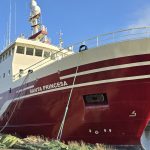According to the council the restructuring of the observer program would put watchers on halibut vessels and ground-fish vessels under 60 feet. The reason behind such a decision is to obtain better information on bycatch, which is any fish caught that the vessel wasn’t originally targeting. But commercial fishermen have some concerns about the program, including its cost.
Jeff Farvour, who fishes for blackcod and halibut, said that if the observer program restructuring gets final approval October, the National Marine Fisheries Service will take that 2 percent he referenced from the value of a vessel’s catch at the dock, which is referred to as the ex-vessel price.
Linda Behnken is executive director of the Alaska Longline Fishermen’s Association, or ALFA. She told that the halibut and sablefish fleet already pays a management and monitoring fee of 3 percent of the ex-vessel price. She added that the data they provided showed their fleet will be paying 25 percent of the costs for the entire Gulf and Bering Sea restructured fisheries, even though they only account for 2 percent of the fish caught.
The North Pacific Fishery Management Council heard testimony on that during its meeting, including from Wendy Alderson, who fishes from a 49-foot vessel. She says the program needs federal funding. Alderson also said that under the new program, she and her husband would not be able to make their annual payments on the loans they used to buy into their individual fishing quotas. And she proposed an alternative to having a human observer aboard.








